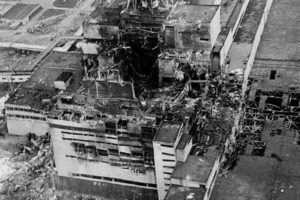
Chernobyl after the blast
Tom Bearden is a retired U.S. Army Lieutenant Colonel who specializes in the science of free energy, scalar weapons, etc.
His theory of what most probably happened at Chernobyl flies in the face of contemporary explanations.
We reproduce an excerpt from one of his technical papers on what happened that day. The language may be a bit technical for some.

Tom Bearden
Tom Bearden, “Weapons that Use Time-Reversed Elecromagnetic Waves,” n.d. at
https://www.cheniere.org/books/excalibur/part4.htm
Any radioactive nucleus is already “teeter-tottering” toward nuclear decay, so to speak, and it will instantly decay radioactively when struck by a significant scalar potential pulse. Thus a TR [time-reversed] wave radar weapon can deliver a powerful TR pulse against a distant vehicle carrying a nuclear warhead, and the resultant EG pulse penetrating the nuclear material of the warhead will electrogravitationally explode it in a full-order nuclear detonation.
Therefore, when using such weapons, extreme care must be taken to avoid inadvertently pulsing one’s own nearby nuclear weapons or nuclear material. In attacking distant ground targets, one must be careful not to detonate nearby nuclear weapons, nuclear powerplants, or stored nuclear material-even at some distance from the target. Otherwise, large-scale nuclear fallout will be experienced over a worldwide area, and unacceptable “boomerang” self-damage to the attacker himself may be incurred. The more powerful the TR pulse employed, the greater the safety separation between the struck target and stored nuclear materiel must be to prevent unacceptable “boomerang” large-scale fallout
Also, large TR wave interferometer weapons, such as the Woodpecker systems, usually first produce very powerful, scalar EM [electromagnetic] “standing wave” beams by continuously transmitting (in the beam) both a normal EM wave and its phase conjugate, modulated (locked) together to produce a “zero EM vector resultant” electrogravitational (EG) wave. Interference of two of these scalar EM beams in the targeted area, plus internal scanning within the beam by other signals, allows EM effects – of either normal EM energy or time-reversed EM energy – to be produced and controlled at very precise locations within the broad interference area.
Each such huge “scalar EM standing wave” beam represents a gigantic electrogravitational standing wave, and hence a giant oscillating potential in spacetime. This standing wave represents a sort of gigantic “capacitor”, or accumulator of infolded energy. Enormous energy may be collected in this potential, charged-up over a period of time. “Shortout” of this giant capacitor – by transmitter failure – can result in a large flash-over discharge of the EG energy into the local earth, producing a massive EG ground wave that can be enormously destructive.
Thus one must carefully protect the TR wave weapon system from inadvertent discharge of large EG pulses into the earth at the local site, due to transmitter failure, shortouts, etc. Otherwise one’s own nuclear weapons or facilities may be exploded – even at some distance – by the EG pulse ground wave produced. One’s communications and electronics installations, for example, can be knocked out at an even greater distance.
For example, in the winter of 1957-58, a large Soviet TR wave prototype weapon at Kyshtym, near the Urals, apparently suffered a catastrophic transmitter failure, discharging a powerful scalar EM (electrogravitational, or EG) pulse into the earth. This huge EG pulse struck the atomic wastes stored nearby, causing the radioactive nuclei to immediately decay. In other words, the nearby atomic wastes exploded – just as eye-witnesses reported. Deadly radioactive contamination spread across a major region, and exists to this day.
After this accident, the Soviets would have developed much more elaborate safety circuits and devices and implemented them into their TR wave weapons.
Even so, in April 1986, the explosive eruption of a reactor at Chernobyl was almost certainly caused by an accidental catastrophic failure of a large TR Woodpecker transmitter about 30 kilometers away. The sudden failure of the East-to-West Woodpecker transmitter was positively detected by engineer Bill Bise. All safety circuits at the site would have been instantly activated, desperately and slowly draining off the huge “standing wave” potential built up by the weapon.
The Soviets would have immediately shut down the reactors at Chernobyl as a precaution.
Some hours later, the transmitter safety devices finally failed, and a much smaller, though still significant, remnant EG pulse was discharged into the earth, spreading out in a ground wave. The first radioactive material – the fuel rods in one of the hapless, shutdown Chernobyl reactors – encountered by the EG ground wave pulse received it and immediately erupted radioactively.
Had the full EG pulse escaped the stricken transmitter, all four reactors at Chernobyl would have violently exploded, and deadly nuclear fallout would have rained down over a wide area of the earth. Had the reactors not been shut down and the control rods inserted “full-in” to dampen the radioactivity, a far greater radioactive eruption – probably a nuclear explosion – of the struck reactor would have occurred.

